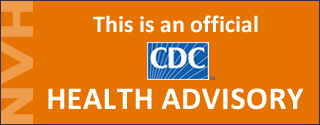Ebola Virus Disease Confirmed in a Traveler to Nigeria, Two U.S. Healthcare Workers in Liberia
Distributed via the CDC Health Alert Network
July 28, 2014, 16:30 ET (4:30 PM ET)
CDCHAN-00363
Summary
Nigerian health authorities have confirmed a diagnosis of Ebola Virus Disease (EVD) in a patient who died on Friday in a hospital in Lagos, Nigeria, after traveling from Liberia on July 20, 2014. The report marks the first Ebola case in Nigeria linked to the current outbreak in the West African countries of Guinea, Sierra Leone, and Liberia. Health authorities also reported this weekend that two U.S. citizens working in a hospital in Monrovia, Liberia, have confirmed Ebola virus infection. These recent cases, together with the continued increase in the number of Ebola cases in West Africa, underscore the potential for travel-associated spread of the disease and the risks of EVD to healthcare workers. While the possibility of infected persons entering the U.S. remains low, the Centers for Disease Control and Prevention (CDC) advises that healthcare providers in the U.S. should consider EVD in the differential diagnosis of febrile illness, with compatible symptoms, in any person with recent (within 21 days) travel history in the affected countries and consider isolation of those patients meeting these criteria, pending diagnostic testing.
Background
CDC is working with the World Health Organization (WHO), the ministries of health of Guinea, Liberia, and Sierra Leone, and other international organizations in response to an outbreak of EVD in West Africa, which was first reported in late March 2014. As of July 23, 2014, according to WHO, a total of 1,201 cases and 672 deaths (case fatality 55-60%) had been reported in Guinea, Liberia, and Sierra Leone. This is the largest outbreak of EVD ever documented and the first recorded in West Africa.
EVD is characterized by sudden onset of fever and malaise, accompanied by other nonspecific signs and symptoms, such as myalgia, headache, vomiting, and diarrhea. Patients with severe forms of the disease may develop multi-organ dysfunction, including hepatic damage, renal failure, and central nervous system involvement, leading to shock and death.
In outbreak settings, Ebola virus is typically first spread to humans after contact with infected wildlife and is then spread person-to-person through direct contact with bodily fluids such as, but not limited to, blood, urine, sweat, semen, and breast milk. The incubation period is usually 8–10 days (rarely ranging from 2–21 days). Patients can transmit the virus while febrile and through later stages of disease, as well as postmortem, when persons contact the body during funeral preparations.
On July 25, the Nigerian Ministry of Health confirmed a diagnosis of EVD in a man who died in a hospital in Lagos (population ~21 million). The man had been in isolation in the hospital since arriving at the Lagos airport from Liberia, where he apparently contracted the infection. Health authorities are investigating whether passengers or crew on the plane or other persons who had contact with the ill traveler are at risk for infection.
In addition, health authorities have reported that two U.S. healthcare workers at ELWA hospital in Monrovia, Liberia, have confirmed Ebola virus infection. One of the healthcare workers, a physician who worked with Ebola patients in the hospital, is symptomatic and in isolation. The other healthcare worker, a hygienist, developed fever but is showing no other signs of illness. The physician is an employee of Samaritan’s Purse, a North Carolina-based aid organization that has provided extensive assistance in Liberia since the beginning of the current outbreak. The other healthcare worker works with Serving in Mission (SIM) in Liberia and was helping the joint SIM/Samaritan’s Purse team.
The recent cases in a traveler and in healthcare workers demonstrate the risk for spread of EVD in these populations. While no EVD cases have been reported in the United States, a human case, caused by a related virus, Marburg virus, occurred in Denver, Colorado in 2008. Successful implementation of standard precautions was sufficient to limit onward transmission. Other imported cases of viral hemorrhagic fever disease were also successfully managed through effective barrier methods, including a recent Lassa fever case in Minnesota.
Recommendations
EVD poses little risk to the U.S. general population at this time. However, U.S. healthcare workers are advised to be alert for signs and symptoms of EVD in patients with compatible illness who have a recent (within 21 days) travel history to countries where the outbreak is occurring, and should consider isolation of those patients meeting these criteria, pending diagnostic testing.
For More Information
Additional information on EVD can be found at: https://www.cdc.gov/ebola
Interim Guidance on EVD for healthcare workers can be found at: https://www.cdc.gov/vhf/abroad/healthcare-workers.html
Travel notices for each country can be found at:
Guinea: http://wwwnc.cdc.gov/travel/notices/alert/ebola-guinea
Liberia: http://wwwnc.cdc.gov/travel/notices/alert/ebola-liberia
Sierra Leone: http://wwwnc.cdc.gov/travel/notices/alert/ebola-sierra-leone
The Centers for Disease Control and Prevention (CDC) protects people’s health and safety by preventing and controlling diseases and injuries; enhances health decisions by providing credible information on critical health issues; and promotes healthy living through strong partnerships with local, national and international organizations.
Department of Health and Human Services
HAN Message Types
- Health Alert: Conveys the highest level of importance about a public health incident.
- Health Advisory: Provides important information about a public health incident.
- Health Update: Provides updated information about a public health incident.
###
This message was distributed to state and local health officers, state and local epidemiologists, state and local laboratory directors, public information officers, HAN coordinators, and clinician organizations.
###

